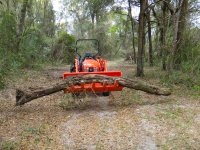MichiganIron
Silver Member, Advertiser
- Joined
- May 12, 2008
- Messages
- 833
- Location
- Central Michigan
- Tractor
- Full line of KIOTI Tractors, BEFCO and Worksaver Implements
The tractor needs to be ballasted to use the Front Loader to it's capacity. You will find the ballst listed in the Front Loader Owners Manual. Filling the rear tires is a convenient way to add ballast to the tractor, but not necessarily the best way. With the ballast in the rear tires, or at the rear axle, the front axle is a folcrum from the front loader picked and dead weight. If you pick a load with the bucket, and the ballast is at the rear axle, the front axle is the folcrum.
If you add the weight to the 3-point hitch, you distribute the front loader reaction over both axles of the tractor. We did a computer model several years ago for a KIOTI CK30 with a 1000lb picked load and 500lb ballast. We first put the 500lb ballst at the rear axle. The reaction at the front axle is 1750lbs. We then moved the same ballast to the 3-point hitch. The reaction at the front axle with the ballast at the 3-point hitch was 1200 pounds. This is a 34% reduction in front axle load just by moving the ballst to the 3-Point, and distributing the load more evenly accross both axles of the tractor. Not only will this extend the life of the front axle, it improves the handling of the tractor while carrying a load significantly.
We always explain the difference to potential customers and let them decide. Some applications require tight operating conditions where a ballast on the 3-point would be a problem. Most often, the 3-point is the best way to ballst a tractor. Nothing wrong with doing both.
The original reason for ballasting rear tires was for traction in the field. When Front Loaders came on the scene, it seemed natural to use it as loader ballast.
Hope this helps
If you add the weight to the 3-point hitch, you distribute the front loader reaction over both axles of the tractor. We did a computer model several years ago for a KIOTI CK30 with a 1000lb picked load and 500lb ballast. We first put the 500lb ballst at the rear axle. The reaction at the front axle is 1750lbs. We then moved the same ballast to the 3-point hitch. The reaction at the front axle with the ballast at the 3-point hitch was 1200 pounds. This is a 34% reduction in front axle load just by moving the ballst to the 3-Point, and distributing the load more evenly accross both axles of the tractor. Not only will this extend the life of the front axle, it improves the handling of the tractor while carrying a load significantly.
We always explain the difference to potential customers and let them decide. Some applications require tight operating conditions where a ballast on the 3-point would be a problem. Most often, the 3-point is the best way to ballst a tractor. Nothing wrong with doing both.
The original reason for ballasting rear tires was for traction in the field. When Front Loaders came on the scene, it seemed natural to use it as loader ballast.
Hope this helps
Last edited:


